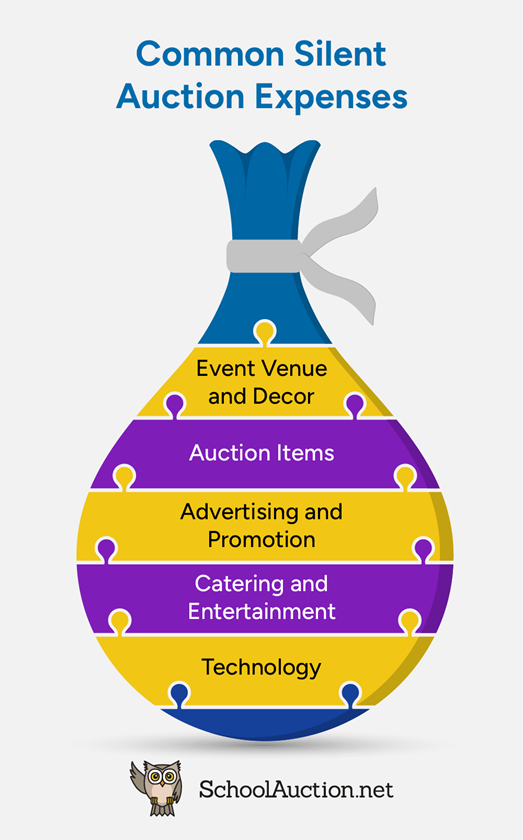Silent Auction Budgeting 101: Fundraising Success Strategies

Silent auctions are exciting opportunities to raise funds and create fun, memorable experiences for guests. By properly budgeting for your silent auction, you can avoid unnecessary expenses and maximize your fundraising potential. Plus, a well-crafted budget streamlines auction planning by helping you allocate funds to the areas that matter most.
Let’s break down four silent auction budgeting strategies you can implement today:
1. Set Clear Budgeting Goals
Collaborate with your team to think through your event logistics and set clear markers for success. Doing so ensures you have specific goals for both planning and executing your event.
Items you might calculate include:
- Estimated Total Revenue: Estimate how much you expect to raise through this fundraising event. Categorize your expected income from various revenue streams such as individual donations, ticket sales, sponsorships, and auction item revenue.
- Estimated Total Expenses: Outline your predicted expenses to estimate your total event cost. For instance, consider administrative costs, marketing costs, and other auction-specific expenses (more on this later).
- Calculated Return per Dollar (RPD): Calculate the RPD by dividing your total revenue by the total expenses. A higher RPD indicates higher fundraising success. For instance, if your organization spends $10,000 to host an event and raises $30,000, the RPD would be calculated as follows:
- RPD = ($30,000 / $10,000) = 3
- This figure indicates that for every dollar spent, you raised three dollars.
- Calculated Return on Investment (ROI): This metric refers to the amount of money your organization expects to raise in relation to the money spent organizing it. To calculate ROI, subtract your total expected expenses from your estimated revenue, divide this number by the total expenses, and then multiply it by 100. For instance, if your organization spends $10,000 to host an auction and raises $30,000 from the event, the ROI would be calculated as follows:
- ($30,000-$10,000) / $10,000 = 2 x 100 = 200%
- This number indicates a 200% return on investment, meaning you made a profit of two dollars for every dollar spent after covering all costs.
- Maximum Spending Limits: After determining your expected revenue and ROI, set clear caps for different categories of your budget to avoid overspending. For example, decide on the maximum amount you will spend on marketing, catering, and venue rental to ensure your organization does not exceed spending limits and negatively impact your ROI.
Next, you’ll develop a strategy for achieving these budgeting goals, taking your anticipated expenses into account.
2. List Out Your Predicted Expenses
It's important to balance your spending carefully—you want to invest enough to ensure a high-quality experience for your attendees while still meeting your fundraising goals.
Striking this balance requires tallying your potential expenditures. Some common silent auction costs to consider include:

- Event Venue and Decor: For hybrid or in-person auctions, you’ll need to set aside expenses for a venue and decorations. If you decide to take your silent auction online, make it more engaging by adding gamification elements like out-bid notifications and countdowns.
- Auction Items: While many donors generously provide items or services as donations, consider allocating funds to secure a few consignment items for your auction. A well-rounded selection of items that cater to different interests and budgets will drive up bidding and engage all attendees.
- Advertising and Promotion: Paid ads on social media, radio stations, and newspapers can boost awareness of your upcoming auction. At the same time, you can use your own social media posts, website, and printed flyers as low-cost ways to spread the word to your community.
- Catering and Entertainment: If your silent auction is live, what other elements will you add to make the night special? See if you can partner with a local restaurant and ask if they’d be willing to cater your event at a discounted price.
- Technology: Many auction planners use silent auction software to facilitate bidding and provide a smooth experience for all attendees. Look for a provider with a user-friendly interface, transparent pricing, and reliable customer support. Also, consider what lighting and AV equipment you may need—will the venue provide it all, or should you budget for rental?
Once you’ve identified all your predicted expenses, look for ways to cut down on costs without sacrificing event quality. For example, you could look into potential sponsorships from local businesses that may be willing to cover some auction expenses in exchange for brand promotion in your event materials.
3. Conduct Audience Research to Inform Your Planning
The more you know about your audience, the better you can tailor your silent auction to meet their expectations and generate more revenue. That’s why it’s essential to procure auction items that your guests will be interested in. For instance, a school’s auction attendees will likely prefer different auction items than guests of an annual charity gala.
To identify items that will capture your guests’ attention, consider these factors:
- Demographics: Understanding your audience's age, gender, profession, and cultural background will help you select items that resonate with their preferences. For instance, if your guest list primarily consists of young professionals, tech gadgets or experience-based items might be most appealing.
- Income: Assess the general income levels of your attendees to determine the price range for auction items. High-income guests might be more inclined to bid on luxury items or exclusive experiences, whereas a middle-income audience might appreciate practical items with a reasonable starting bid.
- Interests: Your guest list may include sports fans, artists, cooking connoisseurs, and fitness fanatics. For example, if you have more sports-inclined guests, you may focus your procurement on a new set of golf clubs rather than an original painting.
- Community Involvement: Consider how connected your audience is to local causes. Maybe some of your guests are involved in a community vegetable garden. Recipe books and gardening tools might catch their eye.
- Past Top-Performing Items: If you’re not sure where to start, research previous top performers. Or, attend other local silent auctions to get an idea of which items were best-sellers and which ones to avoid.
If you're still unsure which auction items will resonate with your audience, consider sending out a survey beforehand to collect direct feedback from potential attendees. Doing so can help you fine-tune your selection to better meet their expectations.
4. Be strategic about auction item pricing
Setting the right price for auction items is crucial for maximizing revenue without discouraging bids. According to SchoolAuction.net’s pricing guide, you should set your opening bids between a third and a half of an item’s Fair Market Value (FMV), which is the item’s sale value as determined by the item donor.
For items without a retail tag, such as an autographed baseball, research sales of similar items to confirm their value. Use resources like eBay and Amazon to verify FMV or jump-start your research for items with an undetermined value. From there, you can determine:
- Starting Bids, which set the tone for bidding activity. They should be low enough to entice participation but high enough to reflect the item's value and potential. The general rule of thumb is to set your starting bid at 30-50% of an item’s FMV.
- Bid Increments, which influence the auction’s pace and excitement. Best practice is to set your bid increments at 10% of an item’s FMV. Consider going up to 15% for popular, high-ticket items. You generally do not want more than 7-8 bid increments between the opening bid and the FMV of the item, in order to maximize your revenue from the bidding.
- Buy-It-Now Options, which can be a great way to secure immediate sales at a premium price. There are typically a few items that draw the most bids—front-row concert tickets, fancy dinner certificates, or weekend getaways. Offer a buy-it-now option at 150%-200% FMV for bidders willing to pay top dollar.
To further increase bidder interest in your silent auction items, consider strategies like auction item bundling. Combining related items or experiences into attractive packages can create more perceived value and spark bidding wars. For instance, you could pair a spa treatment with a luxury hotel stay and group a gourmet cooking set with a private cooking class.
After your silent auction wraps up, take a comprehensive look at the financial outcomes. Reviewing the total revenue and expenses, along with metrics like RPD and ROI, will give you a clear picture of your event's profitability and lay the groundwork for more effective budgeting in the future.
 Roger Devine is a co-founder of Northworld, the developer and distributor of the award-winning SchoolAuction.net auction management software. Roger has 30+ years of experience working in software, website development, and publishing. He has chaired at least 30 auctions over the past 20 years and has served on the boards of several area nonprofits, including K9 Kavalry and the Golden Leaf Education Foundation. Roger currently lives in Portland, OR, and loves all dogs on the planet.
Roger Devine is a co-founder of Northworld, the developer and distributor of the award-winning SchoolAuction.net auction management software. Roger has 30+ years of experience working in software, website development, and publishing. He has chaired at least 30 auctions over the past 20 years and has served on the boards of several area nonprofits, including K9 Kavalry and the Golden Leaf Education Foundation. Roger currently lives in Portland, OR, and loves all dogs on the planet.




